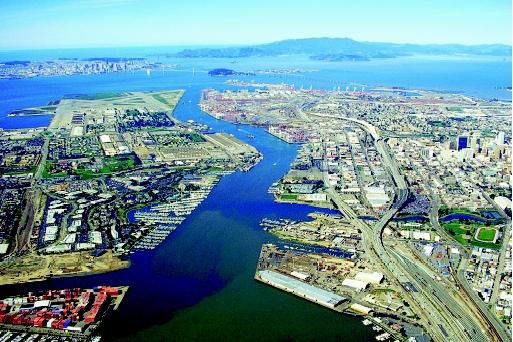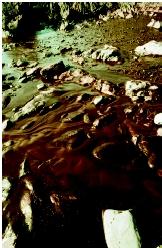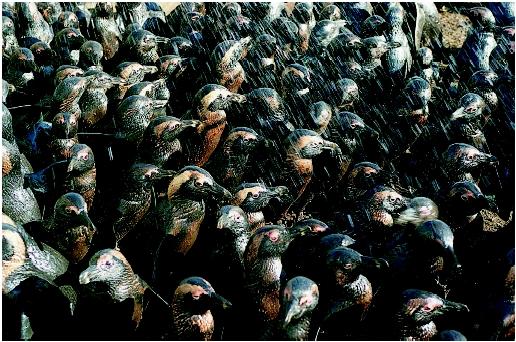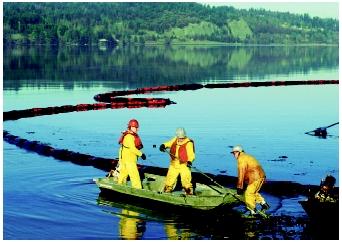Oil wastes that enter the ocean come from many sources, some being accidental spills or leaks, and some being the results of chronic and careless habits in the use of oil and oil products. Most waste oil in the ocean consists of oily stormwater drainage from cities and farms, untreated waste disposal from factories and industrial facilities, and unregulated recreational boating.
It is estimated that approximately 706 million gallons of waste oil enter the ocean every year, with over half coming from land drainage and waste disposal; for example, from the improper disposal of used motor oil. Offshore drilling and production operations and spills or leaks from ships or tankers typically contribute less than 8 percent of the total. The remainder comes from routine maintenance of ships (nearly 20 percent),
hydrocarbon particles from onshore air pollution (about 13 percent), and natural seepage from the seafloor (over 8 percent).
Prevalence during Drilling versus Transportation
Offshore oil spills or leaks may occur during various stages of well drilling or workover and repair operations. These stages can occur while oil is being produced from offshore wells, handled, and temporarily stored; or when oil is being transported offshore, either by flowline, underwater pipeline, or tanker. Of the approximately 706 million gallons of waste oil in the ocean each year, offshore drilling operations contribute about 2.1 percent, and transportation accidents (both ships and tankers) account for another 5.2 percent. The amount of oil spilled or leaked during offshore production operations is relatively insignificant.
Oil waste from offshore drilling operations may come from disposal of oil-based drilling fluid wastes, deck runoff water, flowline and pipeline leaks, or well failures or blowouts. Disposal of offshore production waste can also pollute the ocean, as can deck runoff water, leaking storage tanks, flowline and pipeline leaks, and the wells themselves. Oil spilled from ships and tankers includes the transportation fuel used by the vessels themselves or their cargos, such as crude oil, fuel oil, or heating oil.

Over half the ocean's waste oil comes from land-based sources and from unregulated recreational boating. The heavy development in this busy California port illustrates one potential source of petroleum contamination in coastal waters. (Note dark plume in left foreground.)
Oil Spill Behavior
When oil is spilled in the ocean, it initially spreads in the water (primarily on the surface), depending on its relative density and composition. The oil slick formed may remain cohesive, or may break up in the case of rough seas. Waves, water currents, and wind force the oil slick to drift over large areas, impacting the open ocean, coastal areas, and marine and terrestrial habitats in the path of the drift.
Oil that contains volatile organic compounds partially evaporates, losing between 20 and 40 percent of its mass and becoming denser and more viscous (i.e., more resistant to flow). A small percentage of oil may dissolve in the water. The oil residue also can disperse almost invisibly in the water or form a thick mousse with the water. Part of the oil waste may sink with suspended particulate matter, and the remainder eventually congeals into sticky tar balls. Over time, oil waste weathers (deteriorates) and disintegrates by means of photolysis (decomposition by sunlight) and biodegradation (decomposition due to microorganisms). The rate of biodegradation depends on the availability of nutrients, oxygen, and microorganisms, as well as temperature.
Oil Spill Interaction with Shoreline.
If oil waste reaches the shoreline or coast, it interacts with sediments such as beach sand and gravel, rocks and boulders, vegetation, and terrestrial habitats of both wildlife and humans, causing erosion as well as
contamination . Waves, water currents, and wind move the oil onto shore with the surf and tide.

Crude oil from the Sea Empress tanker spill coats a beach at Pembrokeshire, Wales in 1996. Although marine transportation accidents can result in such oil spills, they account for only about 5 percent of the waste oil that enters the ocean annually.
Beach sand and gravel saturated with oil may be unable to protect and nurture normal vegetation and populations of the substrate
biomass . Rocks and boulders coated with sticky residue interfere with recreational uses of the shoreline and can be toxic to coastal wildlife.
Examples of Large Spills.
The largest accidental oil spill on record (Persian Gulf, 1991) put 240 million gallons of oil into the ocean near Kuwait and Saudi Arabia when several tankers, port facilities, and storage tanks were destroyed during war operations. The blowout of the Ixtoc I exploratory well offshore Mexico in 1979, the second largest accidental oil spill, gushed 140 million gallons of oil into the Gulf of Mexico. By comparison, the wreck of the Exxon Valdez tanker in 1989 spilled 11 million gallons of oil into Prince William Sound offshore Alaska, and ranks fifty-third on the list of oil spills involving more than 10 million gallons.
The number of large spills (over 206,500 gallons) averaged 24.1 per year from 1970 to 1979, but decreased to 6.9 per year from 1990 through 2000.
Damage to Fisheries, Wildlife, and Recreation
Oil spills present the potential for enormous harm to deep ocean and coastal fishing and fisheries. The immediate effects of toxic and smothering oil waste may be mass mortality and contamination of fish and other food species, but long-term ecological effects may be worse. Oil waste poisons the sensitive marine and coastal organic substrate, interrupting the food chain on which fish and sea creatures depend, and on which their reproductive success is based. Commercial fishing enterprises may be affected permanently.
Wildlife other than fish and sea creatures, including mammals, reptiles, amphibians, and birds that live in or near the ocean, are also poisoned by oil waste. The hazards for wildlife include toxic effects of exposure or ingestion, injuries such as smothering and deterioration of thermal insulation, and damage to their reproductive systems and behaviors. Long-term ecological effects that contaminate or destroy the marine organic substrate and thereby interrupt the food chain are also harmful to the wildlife, so species populations may change or disappear.
Coastal areas are usually thickly populated and attract many recreational activities and related facilities that have been developed for fishing, boating, snorkeling and scuba diving, swimming, nature parks and preserves, beaches, and other resident and tourist attractions. Oil waste that invades and pollutes these areas and negatively affects human activities can have devastating and long-term effects on the local economy and society. Property values for housing tend to decrease, regional business activity declines, and future investment is risky.
Long-term Fate of Oil on Shore
The fate of oil residues on shore depends on the spilled oil's composition and properties, the volume of oil that reaches the shore, the types of beach and coastal sediments and rocks contacted by the oil, the impact of the oil on sensitive habitats and wildlife, weather events, and seasonal and climatic conditions. Some oils evaporate, disperse, emulsify, weather, and decompose more easily than others. The weather and seasonal and climatic conditions may accelerate or delay these processes.

In 2000, several thousand penguins were affected by a fuel oil spill after the iron-ore carrier Treasure sank off South Africa. Many oil-soaked birds were cleaned and released.
Oil waste that coalesces into a tar-like substance or that saturates sediments above the surf and tide level is especially persistent. Efforts to remove the oil and clean, decontaminate, and remediate an oil-impacted shoreline may make the area more visibly attractive, but may be more harmful than helpful in terms of actual recovery.
Cleanup and Recovery
The techniques used to clean up an oil spill depend on oil characteristics and the type of environment involved; for example, open ocean, coastal, or wetland . Pollution-control measures include containment and removal of the oil (either by skimming, filtering, or in situ combustion), dispersing it into smaller droplets to limit immediate surficial and wildlife damage, biodegradation (either natural or assisted), and normal weathering processes. Individuals of large-sized wildlife species are sometimes rescued and cleaned, but micro-sized species are usually ignored.
Oil spill countermeasures to clean up and remove the oil are selected and applied on the basis of many interrelated factors, including ecological protection, socioeconomic effects, and health risk. It is important to have contingency plans in place in order to deploy pollution control personnel and equipment efficiently.
Environmental Recovery Rates.
The rate of recovery of the environment when an oil spill occurs depends on factors such as oil composition and

Workers clean up an oil refinery spill that polluted Anacortes Bay, Washington. The floating ring of absorbent pads trailing behind the boat is being used to contain some of the oil that has spilled.
properties and the characteristics of the area impacted, as well as the results of intervention and remediation. Physical removal of oil waste and the cleaning and decontaminating of the area assist large-scale recovery of the environment, but may be harmful to the substrate biomass. Bioremediation efforts—adding microorganisms, nutrients, and oxygen to the environment—can usually boost the rate of biodegradation. Because of the type of oil spilled and the Arctic environment in which it spilled, it is estimated that the residue of the
Exxon Valdez oil spill will be visible on the Alaskan coast for 30 years.
Costs and Prevention
The costs of an oil spill are both quantitative and qualitative. Quantitative costs include loss of the oil, repair of physical facilities, payment for cleaning up the spill and remediating the environment, penalties assessed by regulatory agencies, and money paid in insurance and legal claims. Qualitative costs of an oil spill include the loss of pristine habitat and communities, as well as unknown wildlife and human health effects from exposure to water and soil pollution.
Prevention of oil spills has become a major priority; and of equal importance, efforts to contain and remove oil that has spilled are considered to be prevention of secondary spills. The costs associated with oil spills and regulations governing offshore facilities and operations have encouraged the development of improved technology for spill prevention. The Oil Pollution Act of 1990 was enacted by the U.S. Congress to strengthen oil spill prevention, planning, response, and restoration efforts. Under its provisions, the Oil Spill Liability Trust Fund provides cleanup funds for oil pollution incidents.
Responsibility for the prevention of oil spills falls upon individuals as well as on governments and industries. Because the sources of oil waste in the ocean are generally careless, rather than accidental, truly effective prevention of oil spills involves everyone.
Carolyn Embach
Bibliography
American Petroleum Institute. Fate of Spilled Oil in Marine Waters. Publication Number 4691. Washington, D.C.: American Petroleum Institute, 1999.
Carls, Mark G. et al. "Persistence of Oiling in Mussel Beds after the Exxon Valdez Oil Spill." Marine Environmental Research 51, no. 2 (2001):167–190.
Raloff, Janet. "Valdez Spill Leaves Lasting Impacts." Science News no. 143 (February 13, 1993):102.
U.S. Environmental Protection Agency. Understanding Oil Spills and Oil Spill Response. Publication Number 9200.5–105. Washington, D.C.: U.S. Environmental Protection Agency, 1993.
RECOVERING FROM THE EXXON VALDEZ OIL SPILL
A large quantity of crude oil was deposited on beaches in Prince William Sound and along the shoreline of the Gulf of Alaska after the Exxon Valdez tanker wrecked in 1989. The oil waste has been closely monitored to determine its status and its effects in the ocean and along the coast.
Initial efforts to remove the oil from intertidal areas included flushing them with hot water applied with high pressure, which proved fatal for much of the marine life involved. Natural rates of biodegradation and recovery have been slower than anticipated, and visible residue may persist for up to 30 years.


















